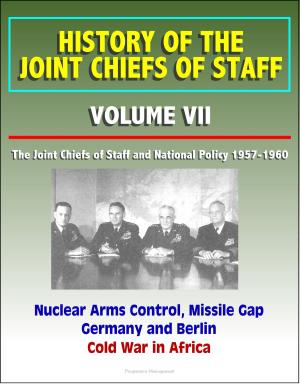The United States Air Force (USAF) in Southeast Asia: Development and Employment of Fixed-Wing Gunships 1962-1972 - AC-47, AC-130, AC-119, Commando Hunt, Chase Aircraft
Nonfiction, History, Military, Vietnam War, Asian, Aviation| Author: | Progressive Management | ISBN: | 9781311169358 |
| Publisher: | Progressive Management | Publication: | July 11, 2015 |
| Imprint: | Smashwords Edition | Language: | English |
| Author: | Progressive Management |
| ISBN: | 9781311169358 |
| Publisher: | Progressive Management |
| Publication: | July 11, 2015 |
| Imprint: | Smashwords Edition |
| Language: | English |
Professionally converted for accurate flowing-text e-book format reproduction, this unique USAF publication traces the gunship's history from initial conception in the early 1960s through deployment and operations to the end of American combat involvement in early 1973.
One of the more striking aspects of the war in Southeast Asia was the adaptation of existing weapons in the American arsenal to the peculiar needs of an unconventional war. Total air superiority presented to the United States great opportunities to support ground operations. Very early some in the Air Force saw the need for a system that could saturate the ground with fire for interdicting enemy reinforcements, for supporting ground troops in contact with the enemy, and for defending isolated hamlets and outposts under attack. Such a weapons system had to be able to hit small, often fleeting targets in difficult terrain, at night, and in bad weather, through thick jungle cover. It had to be flexible and survivable, to linger for a protracted time over targets, and above all it had to possess great firepower. Nothing in the inventory could do all of this, so the Air Force developed the fixed-wing gunship.
Gunship theory—flying an airplane in a pylon turn to aim side-mounted guns at a fixed point on the ground—had been known for years. But it took men of vision and persistence to mate the theory with modern technology, and then sell the idea to higher authorities. Once the concept had been accepted, the resulting family of gunships was designed to meet specific requirements, then modified as requirements changed. The result was one of the most innovative and successful weapons used in the war.
As impressive as was the hardware, the author does not ignore the human element. The gunship program had its share of high-level indecision, production snarls, and equipment failure; but these were overcome by sound management and determination. Sometimes tactics were faulty, even dangerous, and had to be adjusted to the realities of combat. Gunship crews enjoyed a relatively wide latitude in methods of attacking individual targets; not infrequently they found themselves acting as airborne commanders directing the employment of other strike aircraft. Most of the tactical decisions and a large number of key management decisions were made by officers of surprisingly junior rank. The gunship story shows that the individual still makes a difference in modern war, no matter what the dependence on technology.
One of the most instructive aspects of Ballard's volume is the relationship between theory and experience. Theory drove the initial design concept and employment, but experience in combat drove modification of the aircraft and execution of tactics throughout the war. While the evolution of the gunship and the changing character of its use were not always smooth processes, the gunship worked successfully. The goal of meeting mission requirements always remained paramount.
Lt. Col. Ballard interviewed many key participants involved in this story and gathered extensive data relating to this unique weapon. His principal sources include official letters, messages, memoranda, reports, and minutes of meetings. Most of his research was conducted in the Office of Air Force History, the Albert F. Simpson Historical Research Center and Air University Library, Maxwell Air Force Base, Ala., in the records of the Air Staff, and Offices of the Secretary of the Air Force.
Professionally converted for accurate flowing-text e-book format reproduction, this unique USAF publication traces the gunship's history from initial conception in the early 1960s through deployment and operations to the end of American combat involvement in early 1973.
One of the more striking aspects of the war in Southeast Asia was the adaptation of existing weapons in the American arsenal to the peculiar needs of an unconventional war. Total air superiority presented to the United States great opportunities to support ground operations. Very early some in the Air Force saw the need for a system that could saturate the ground with fire for interdicting enemy reinforcements, for supporting ground troops in contact with the enemy, and for defending isolated hamlets and outposts under attack. Such a weapons system had to be able to hit small, often fleeting targets in difficult terrain, at night, and in bad weather, through thick jungle cover. It had to be flexible and survivable, to linger for a protracted time over targets, and above all it had to possess great firepower. Nothing in the inventory could do all of this, so the Air Force developed the fixed-wing gunship.
Gunship theory—flying an airplane in a pylon turn to aim side-mounted guns at a fixed point on the ground—had been known for years. But it took men of vision and persistence to mate the theory with modern technology, and then sell the idea to higher authorities. Once the concept had been accepted, the resulting family of gunships was designed to meet specific requirements, then modified as requirements changed. The result was one of the most innovative and successful weapons used in the war.
As impressive as was the hardware, the author does not ignore the human element. The gunship program had its share of high-level indecision, production snarls, and equipment failure; but these were overcome by sound management and determination. Sometimes tactics were faulty, even dangerous, and had to be adjusted to the realities of combat. Gunship crews enjoyed a relatively wide latitude in methods of attacking individual targets; not infrequently they found themselves acting as airborne commanders directing the employment of other strike aircraft. Most of the tactical decisions and a large number of key management decisions were made by officers of surprisingly junior rank. The gunship story shows that the individual still makes a difference in modern war, no matter what the dependence on technology.
One of the most instructive aspects of Ballard's volume is the relationship between theory and experience. Theory drove the initial design concept and employment, but experience in combat drove modification of the aircraft and execution of tactics throughout the war. While the evolution of the gunship and the changing character of its use were not always smooth processes, the gunship worked successfully. The goal of meeting mission requirements always remained paramount.
Lt. Col. Ballard interviewed many key participants involved in this story and gathered extensive data relating to this unique weapon. His principal sources include official letters, messages, memoranda, reports, and minutes of meetings. Most of his research was conducted in the Office of Air Force History, the Albert F. Simpson Historical Research Center and Air University Library, Maxwell Air Force Base, Ala., in the records of the Air Staff, and Offices of the Secretary of the Air Force.















